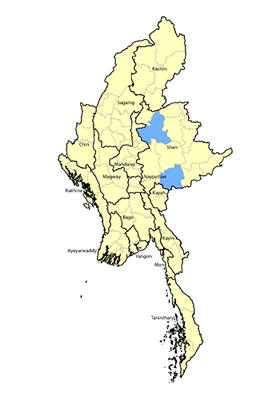The Riang Lang and Riang Lai are closely related and can understand each other's dialect, but they also proudly preserve their own ethnic identities, customs, and clothing styles. The Burmese and Shan have coined nicknames to identify each Riang tribe according to their dress. They call the Riang Lang “Yinnet,” meaning “Black Karen” in Burmese, while the Riang Lai are called “Yinchia,” or “Striped Karen.” In China, the Riang Lang are considered part of the official De'ang minority group, which is the Chinese transliteration of Ta'ang, the self-name of the groups the Burmese call Palaung.
Riang Lang people in Myanmar inhabit villages in the same areas as the Riang Lai group in northern Shan State, concentrated in Namsan and Mantong Townships within the Palaung Self-Administered Zone. Scattered Riang Lang communities are also found over a wide area of the state, including approximately 200 miles (324 km) further south in the Langkho District of southern Shan State, not far from the Thailand border. Approximately 2,000 Riang Lang are also located in southwest China's Yunnan Province.
Riang Lang, which is part of the Mon-Khmer branch of the Austro-Asiatic linguistic family, enjoys vigorous use in their communities. It is reportedly similar to the Danau language spoken over 200 miles (324 km) further south in the Taunggyi District. The Riang languages were first studied at the start of the 20th century, and a contemporary linguist recently found that the Riang Lang language consists of 12 vowels and 21 consonants. Most Riang Lang people can also speak Shan—the language of the dominant ethnicity in that state.
The 1931 census returned 10,867 "Yanglam" people, assumed to be today's Riang Lang. The British colonial rulers called Riang people “Black Karen” because of their appearance, but Riang and Karen have no ethnolinguistic connection, with their languages stemming from two different language families.
The Riang Lang have been subject to abuse over the years. In 2018 they went viral on social media after a woman posted a video saying the Riang Lang were “man-eating ghosts with the power to disguise themselves as humans that can only be seen on moonless nights.” Comments by ignorant people included, “Their teeth are black. They eat human flesh…. You won't see them in the daytime. I've lived here for ages, but I have never seen them. I heard bedtime stories when I was young that they are human-eaters.” In a bid to remain anonymous, the shy Riang Lang even considered discarding their traditional dress because of the outcry against them.
Palestinians are predominantly adherents of Sunni Islam with a minority Christian community. The Holy Land, birthplace of Jesus Christ and the land from where Christianity spread over the entire world, is also the birthplace of the Palestinian Church. The Acts of the Apostles state that the first Christians in Jerusalem were Jews, and historians believe that even after the fall of Jerusalem in A.D. 70, Christianity in the Holy Land kept its Jewish flavor. But the Jewish revolt of Bar-Kokhba in 135 changed all this; Rome showed no mercy to the Jews and obliterated Jerusalem. As a result, the Christian Jewish community effectively disappeared. The conversion of Constantine in 313 gave rise to a new Christian presence in the Holy Land and over the next three centuries, the Holy Land witnessed an influx of Christians from various parts of the Roman empire. Christians became the majority and famous theologians made the Holy Land their home. St. Jerome, who translated the Bible into Latin, was one of these.PRGRPHIn AD 640, Muslim Arabs invaded the Holy Land and took Jerusalem. What followed was the gradual decline of the Church in the Holy Land, as Muslim overlords reduced Christians to servitude. The various Christian sects survived (Greek Orthodox, Ethiopian Orthodox, Nestorians, Syrian Orthodox, Armenians, Copts), and many of their people adopted Arabic as their primary language. Christians from Arabia also joined their brethren in the Holy Land, and the "Palestinian" Arab Christian population began to assume a distinct identity. The Crusader kingdom of the twelfth and thirteenth centuries rose and fell, but Eastern Christians continued to call the Holy Land home despite the return of Muslim power.PRGRPHOver the next 600 years, the heavy taxes and persecution exacted by Muslim sultans impoverished Christian communities. By the nineteenth century, the Christian population in the Holy Land numbered only 15,000. These numbers actually rose over the course of the century, as Ottoman military power declined, and European nations exerted pressure on the Turks to "liberalize" their rule. At the same time, Western Protestants began sending missionaries to the Holy Land. Since the founding of the State of Israel in 1948, massive numbers of Palestinian Christians have left the Holy Land, due to Israeli occupation and the dismal state of the economy in Palestinian towns. Today, Christians make up a small percentage of the West Bank and Gaza Strip (WBGS) Palestinian population.
Palestinian Arabs today face a range of political, economic, and social challenges that shape their daily lives. Many seek statehood, self-determination, and freedom of movement, as checkpoints and travel restrictions limit access to jobs, healthcare, and
Pray for an accurate and complete Bible translation for the Riang Langs.
Pray that oral gospel resources will soon be widely distributed in their villages.
Pray for peace and harmony among different ethnic communities in Northeast India and Myanmar.
Pray for new job opportunities to open for the Riang Langs in Myanmar.
Pray for their hearts to be opened to their need for Jesus Christ.
Pray that soon Riang Lang disciples will make more disciples.
Scripture Prayers for the Riang Lang in Myanmar (Burma).
Asia Harvest, Copyrighted © Used with permission.
Suresha Reang
| Profile Source: Joshua Project |
| Other PDF Profile |












